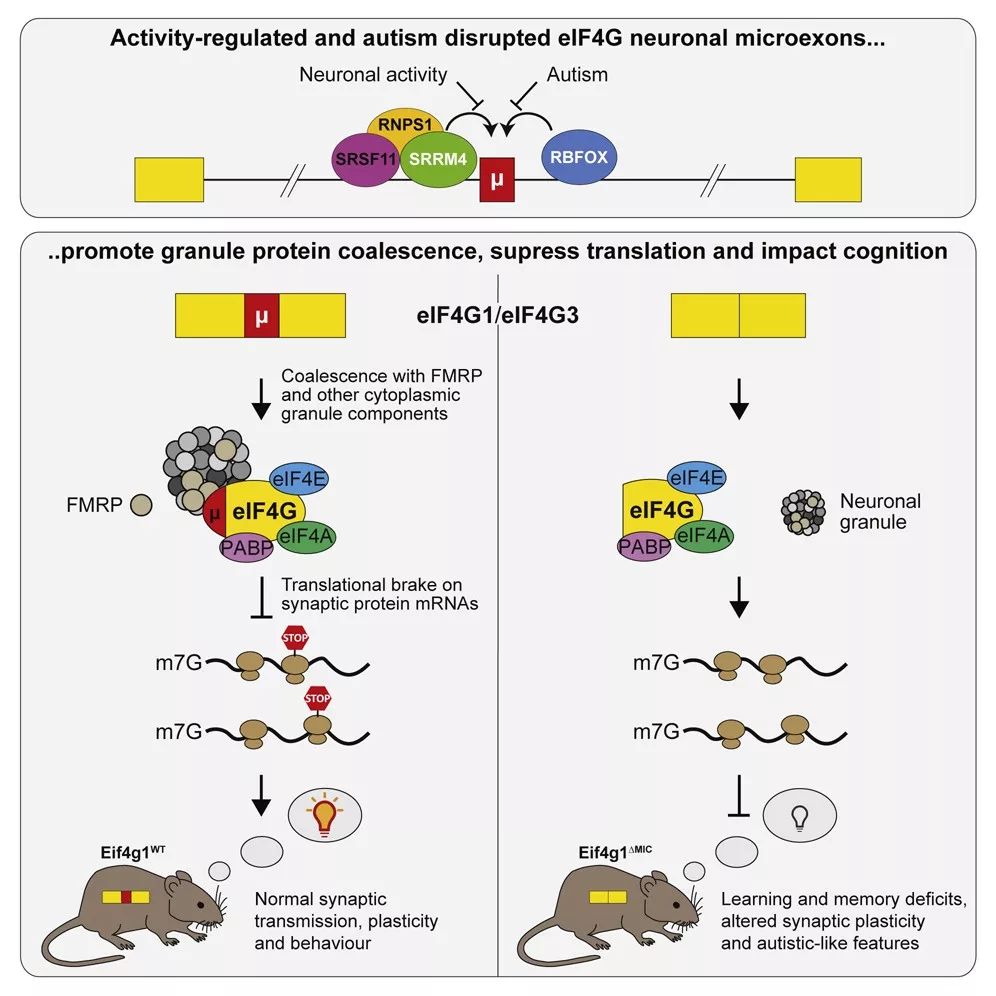科技工作者之家
科界APP是专注科技人才,知识分享与人才交流的服务平台。
科技工作者之家 2020-02-11
来源:逻辑神经科学
原标题:Molecular Cell:多伦多大学学者揭示自闭症失调eIF4G微外显子控制突触翻译和更高级的认知功能
撰文︱王思珍
微外显子(Microexons)是最保守的可变剪接类型,但其功能尚不清楚。
在于2020年1月29日以Autism-Misregulated eIF4G Microexons Control Synaptic Translation and Higher Order Cognitive Functions为题在线发表在Molecular Cell上的文章中,加拿大多伦多大学的Benjamin J. Blencowe教授与加拿大西奈山医院Lunenfeld-Tanenbaum 研究所的高级研究员Sabine P. Cordes博士合作科研团队(Benjamin Blencowe教授课题组的博士后研究员Thomas Gonatopoulos-Pournatzis为文章一作)报道了自闭症中失调的eIF4G微外显子控制突触翻译和更高阶的认知功能。

具体地,首先,作者重点关注了翻译起始因子eIF4G1和eIF4G3中紧密相关的神经微外显子重叠的prion-like结构域,其剪接在自闭症(autism)中具有活动依赖性,而且在自闭症患者其经常是中断裂的。紧接着,对这些微外显子进行CRISPR-Cas9技术基因缺失后,发现其可以特异性地上调控制神经元活性和可塑性的突触蛋白,并进一步触发与激活神经元的相关基因表达程序。
此外,研究人员发现,缺乏Eif4g1微外显子的小鼠表现出了在社会行为、学习和记忆方面的缺陷,并伴有海马突触可塑性的改变。进一步证据表明eIF4G微外显子倾向于与翻译抑制相关的细胞质颗粒组分的结合(包括脆性X智能迟钝(fragile X mental retardation )蛋白FMRP)。从而导致核糖体停滞,再进而起到翻译“刹车”的作用。
因此,以上结果揭示了一种自闭症紊乱的机制:替代剪接特异性地调控神经元翻译,进而控制高级认知功能。

(来源: Gonatopoulos-Pournatzis et al., Molecular Cell January 29, 2020)
原文链接
https://doi.org/10.1016/j.molcel.2020.01.006

Benjamin Blencowe PhD,
Professor
Our research focuses on mechanisms underlying the regulation of gene expression and how these mechanisms are disrupted in human diseases and disorders. Most of our research is directed at understanding how alternative splicing is regulated and integrated with other layers of gene expression to control fundamental biological processes. For example, we have discovered alternative splicing "switches" with critical roles in the regulation of transcriptional programs required for neural and embryonic cell fate. More recently, we have discovered a highly conserved alternative splicing regulatory network involving tiny (3-27 nt) neuronal microexons, and have provided evidence that the disruption of this network represents a common mechanism underlying autism spectrum disorders. Our researchencompasses a wide range of approaches, from bioinformatics and functional genomics to focused molecular, biochemical, cell biological methods, as well as the generation of animal models. We have pioneered the development and application of technologies for the genome-wide quantitative profiling of transcriptomes, RNA interactomes, as well as new CRISPR-based screens designed to comprehensively define RNA regulatory networks. These efforts are uncovering remarkable landscapes of new regulation that await further investigation. They are also providing insight into new therapeutic strategies for human diseases and disorders.

Dr. Sabine Cordes
SENIOR INVESTIGATOR
Dr. Cordes' laboratory is using molecular techniques and analysis of pre-existing and newly generated mouse mutations to understand early neural development, especially that of the vertebrate hindbrain segmentation and serotonergic neuron. To investigate neurotonal specification, Dr. Cordes' lab is focused on identifying new genes required for the development and maintenance of a healthy serotonergic system, with the hope that ultimately these will help improve diagnoses and treatments for patients.
来源:LT-Neuroscience 逻辑神经科学
原文链接:http://mp.weixin.qq.com/s?__biz=MzI4Mjk3NzUxOQ==&mid=2247486055&idx=1&sn=77e95fc6fb6bfe4e713ba569ccf15f54&chksm=eb90ffe7dce776f10c3ea02279e2320d7f4171f264179a0bd921c4a1072042f807c84599a227&scene=27#wechat_redirect
版权声明:除非特别注明,本站所载内容来源于互联网、微信公众号等公开渠道,不代表本站观点,仅供参考、交流、公益传播之目的。转载的稿件版权归原作者或机构所有,如有侵权,请联系删除。
电话:(010)86409582
邮箱:kejie@scimall.org.cn

新研究:自闭症患者并不冷漠|关注世界自闭症日

世界自闭症日:关注自闭症儿童,让他们不再孤独!

自闭症儿童为何“失衡”

自闭症的性别差异

自闭症或与触觉缺陷有关

自闭症与饮食高度相关

自闭症儿童:不是病人,只是与众不同丨世界自闭症日

“垃圾DNA”突变可能引起自闭症

基因疗法新进展!CRISPR技术有望治疗自闭症

自闭症儿童小脑形状异于常人